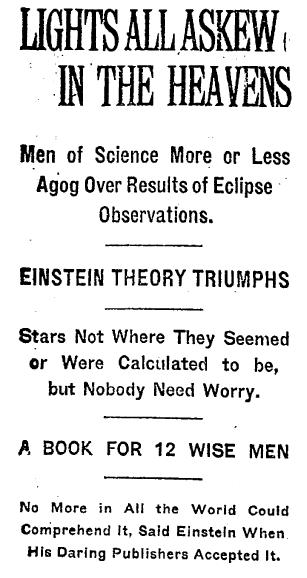THE USM SOUTHWORTH PLANETARIUM
207-780-4249 www.usm.maine.edu/planet
70 Falmouth Street Portland, Maine 04103
43.6667° N 70.2667° W
Altitude: 10 feet below sea level
Altitude: 10 feet below sea level
Founded January 1970
Julian date: 24586323.5
| "Oh leave the Wise our measures to collate One thing at least is certain, light has weight One thing is certain and the rest debate Light rays, when near the Sun, do not go straight." |
THE DAILY ASTRONOMER
Thursday, May 30, 2019
100 Years and One Day Ago on the Space-Time Continuum
Sir Arthur Eddington and Astronomer Royal, Sir Frank Dyson, each lead an expedition to different locations in the Southern Hemisphere in order to observe a total solar eclipse on May 29, 1919. They did not embark on these expeditions merely to observe the spectacle of a total solar eclipse. Instead, they were seeking to confirm a startling prediction made by Einstein's Theory of General Relativity: that the path of starlight is distorted by massive objects. Or, more precisely, by the space-time distortions caused by the presence of massive objects.
As Einstein's theory had been published less than 5 years earlier, none of its tenets had yet been tested. The first "test" was designed to observe the positions of stars around the totally eclipsed Sun. Einstein's theory predicted that the star light around the Sun would experience a 1.75 arc-second deflection. Isaac Newton's model also predicted that light would experience a deflection. However, the Newtonian deflection was about half of that value. Eddington and Dyson were hoping to observe a 1.75 arc-second deflection in the stars close to the solar eclipse so as to provide the first observational evidence in support of the General Theory.
Despite some unsettled weather, Eddington's team captured more than a dozen photographic plates of the total solar eclipse. As totality lasted about six minutes, 51 seconds, they had ample time to capture these images. (The longest possible totality duration is 7 minutes, 31 seconds.) Their measurements determined that some stars showed deflections of about 1.75 arc-seconds, in agreement with Einstein's prediction. While some other astronomers criticized the observations as being insufficiently precise and therefore unable to confirm the deflection, Eddington nevertheless announced his results later that year to the astonishment of the world. The well regarded physicist Albert Einstein was suddenly elevated to the status of global celebrity. The following New York Times headline on November 10, 1919, succinctly summarized the reaction the Eddington experiment results elicited.

One hundred years and a day ago, Eddington and Dyson conducted an experiment that would lend credence to a theory that profoundly altered our view of the Universe. Suddenly, the cosmos no longer seemed like a finely calibrated clockwork mechanism, but was, instead, composed of a strangely malleable structure known as the "space time." Scientists realized that space and time were not disparate aspects of the universe, but were conjoined in one continuum and both could be altered by gravity.
We mark the first centennial of our introduction to a Universe far stranger than humans could ever have imagined.